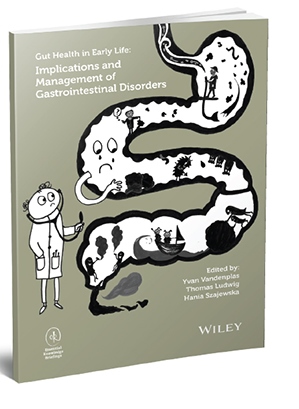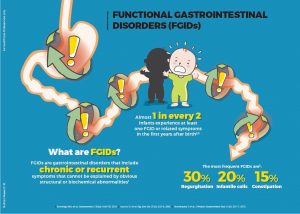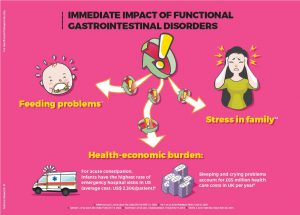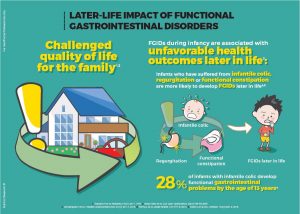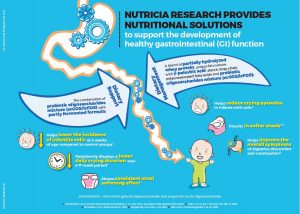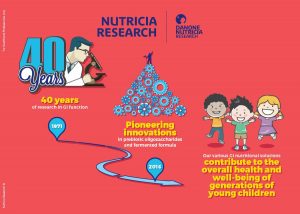The first 1000 days of life lay the foundation for our lifelong health. Receiving optimal nutrition during this period positively impacts the development of the GI tract, as well as the establishment of a balanced gut microbiota.1Wopereis H, et al. Pediatr Allergy Immuno. Published on 2014;25:428-38. An imbalance in gut microbiota during early life may lead to common GI discomforts.2Wopereis H, et al. Pediatr Allergy Immuno. Published on 2014;25:428-38.
‘Gut Health in Early Life: Significance of the Gut Microbiota and Nutrition for Development and Future Health’ provides an overview of early gut development, the role of gut microbiota and how it influences short- and long-term health.

Functional gastrointestinal disorders (FGIDs) in early life
The first weeks and months of life are a period of remarkable growth and development, and our digestive tract has to take over from the placenta immediately after birth. Also, infants have a much smaller stomach and shorter bowel than adults.3Worthington-Roberts B del. et al. In: McGraw-Hill Higher Education USA. Published on 2000 ed 4 ,4Lebenthal E. In: Human gastrointestinal development. Lebenthal E. Raven Press. Published on 1989 New York, 3-18 All these factors have an impact on the way an infant’s digestive system functions, including its ability to digest, absorb and utilise nutrients.
It can take a while for infant’s digestive system to start functioning at full capacity. For example, many young infants produce smaller amount of important enzymes such as pepsin and acids that aid digestion of protein.5Vandenplas Y, et al. Essential Knowledge Briefing. Wiley, Chichester. Published on (2015) Lactose malabsorption (which leads to lactose entering the colon and cause flatulence and cramps) and colonic bacterial fermentation conditions may also cause digestive discomfort in infancy.6Moore DJ. et al. J Pediatr. Published on 1988;113:979-84
During infancy, FGIDs and related symptoms are frequent and have been suggested to be linked to the immaturity of the gut physiology and functionality.

Common FGIDs include regurgitation (30%), infantile colic (20%) and functional constipation (15%).7Vandenplas Y, et al. J Pediatr Gastroenterol Nutr 2. Published on 015;61:531-37 These not only affect the well-being of the infant in both the short and long term, but can also cause distress for their families.8Vik, et al. Acta Paediatr. Published on 2009; 98:1344-8 Furthermore, more frequent healthcare visits result in an increased economic burden on healthcare systems.9Glanville, et al. BMJ Ope. Published on 2016;6:doi 10.1136/bmjopen-2016-011475
More and more experts recognise and acknowledge the value of nutrition, together with parental education and reassurance, in the management of common FGIDs and related symptoms.9
‘Gut Health in Early Life: Implications and Management of Gastrointestinal Disorders’ provides the latest updates in the prevalence, cause, impact, diagnosis and management of common functional gastrointestinal disorders during pregnancy and infancy.
Click Infographic FGID to view the infographic about functional gastrointestinal disorders in infancy and the effect of early life nutrition.
View References
| 1, 2 | Wopereis H, et al. Pediatr Allergy Immuno. Published on 2014;25:428-38. |
|---|---|
| 3 | Worthington-Roberts B del. et al. In: McGraw-Hill Higher Education USA. Published on 2000 ed 4 |
| 4 | Lebenthal E. In: Human gastrointestinal development. Lebenthal E. Raven Press. Published on 1989 New York, 3-18 |
| 5 | Vandenplas Y, et al. Essential Knowledge Briefing. Wiley, Chichester. Published on (2015) |
| 6 | Moore DJ. et al. J Pediatr. Published on 1988;113:979-84 |
| 7 | Vandenplas Y, et al. J Pediatr Gastroenterol Nutr 2. Published on 015;61:531-37 |
| 8 | Vik, et al. Acta Paediatr. Published on 2009; 98:1344-8 |
| 9 | Glanville, et al. BMJ Ope. Published on 2016;6:doi 10.1136/bmjopen-2016-011475 |
